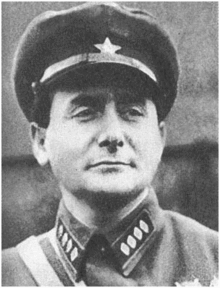Yakov Agranov
This article needs additional citations for verification. (December 2012) |
Yakov Agranov | |
|---|---|
 | |
| First Deputy People's Commissar for Internal Affairs | |
| In office July 1934 – April 1937 | |
| Preceded by | position established |
| Succeeded by | Mikhail Frinovsky |
| Personal details | |
| Born | Yankel Samuilovich Sorenson 12 October 1893 Checherskaya, Gomel Region, Belarus (then Mogilev Governorate, Russian Empire) |
| Died | 1 August 1938 (aged 44) Moscow, Russian SFSR, Soviet Union |
| Awards | Order of the Red Banner (twice) |
| Military service | |
| Allegiance | Soviet Union |
| Branch/service | NKVD |
| Years of service | 1919–1938 |
| Rank | Commissar of State Security 1st rank |

Yakov Saulovich Agranov (
Trial of the Twenty One and the Industrial Party Trial, as well as mass arrests and executions in Saint Petersburg during Joseph Stalin's Great Purge
.
Biography
Agranov was born in 1893Jewish shopkeeper's family in Checherskaya, a village in the Mogilev Governorate of the Russian Empire. In 1912 he joined the Socialist Revolutionary Party while working as a clerk and in 1915 joined the Russian Social Democratic Labour Party. He was arrested by the tsarist police in 1915 and exiled to Yenesei province.
In 1918, Agranov became secretary of
Nikolai Lossky
.
In 1921, Agranov was the chief investigator into the "
Nikolay Gumilyov. All concerned were promptly executed. When asked why he was so merciless, Agranov responded: "Seventy percent of Petrograd intellectuals were standing by one leg in the camp of our enemies. We had to burn that leg off".[3]
Agranov also investigated the
Trotskyist Anti-Soviet Military Organization, the "Promparty"
and "Working Peasant Party" cases. The cynical motto "If there is no enemy, he should be created, denounced and punished" was attributed to Yakov Agranov.
Agranov was also implicated in suspicions concerning the suicide of poet
muse of Mayakovsky.[4]
Immediately after the assassination of
Sergey Kirov in Leningrad on 1 December 1934, Agranov was entrusted with the organization of mass reprisals in the city. Stalin ordered him to fabricate a story that Lev Kamenev, Grigory Zinoviev and other leaders of the opposition were responsible for the murder, but he seems to have resisted, whereupon Stalin entrusted Nikolai Yezhov with the job instead.[5] In 1935, he was ordered by Yezhov to track down and liquidate "an undiscovered centre of Trotskyists" in Moscow, as a preparatory step for the Great Purge that Stalin was planning. When Yezhov took over as head of the NKVD, Agranov remained his First Deputy, and in December 1936 was appointed Head of the Chief Directorate of State Security, which seemingly meant that he was to be trusted to purge the NKVD of officers Yezhov did not trust. In February 1937, he circulated among regional NKVD heads a demand for names of Trotskyists and other oppositionists employed with the state security apparatus. In April, he was demoted to the post of regional NKVD chief in Saratov. He was arrested on 20 July 1937, and appeared on the execution list of 1 November 1937, in which his name was crossed out. He was executed by firing squad as an "enemy of the people" on 1 August 1938.[6]
References
- .
- ISBN 9780375506321.
- ISBN 978-5-93006-033-1 (Russian: Виталий Шенталинский, "Преступление без наказания"), page 214.
- ^ Vitaly Shentalinsky, page 241; Nikolay Punin, husband of Anna Akhmatova, also had an affair with Lilya Brik, according to his published diaries
- ISBN 978-0-8179-2902-2.)
{{cite book}}: CS1 maint: multiple names: authors list (link - ISBN 978-0-8179-2902-2, page 62 (chapter 3), available online at: http://www.hoover.org/publications/books/8348 Archived 26 November 2010 at the Wayback Machine.
